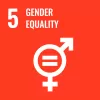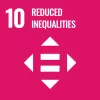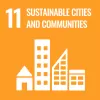Italy
participants
Gathering feedback from youth on how organisations should take an active role in fighting gender discrimination.
Activity Report
The workshop was proposed and delivered by Margherita Protti (ESN MESA München), Riccardo Potenza (ESN Urbino), and Giacomo Torsello (ESN Innsbruck). Riccardo and Giacomo brought the experience they gathered at Eduk8 Starter 2024, while Margherita was familiar with the workshop topic because of her role as her section's Social Impact Manager.
Since the workshop took place at the end of the General Assembly of ESN Italy, which had a very packed agenda and social program, the trainers put extra care into meeting the needs of their participants by hosting the workshop in a quiet outside area near the lake Terlago, offering fruit, cookies, juice and ice tea to the participants, and trying to create an atmosphere of familiarity and relax.
The participants had different levels of experience with the topic. Some participants had never really given much thought to the concept of a safe space. Some of them were active on the National level of their NOs and had had experience of being part of a Safe Team during an event. Some participants had previously taken part in ESN Italy's project "Gender in the Spotlight" and we recommend that ESN International works in synergy with ESN Italy to make sure the entire network benefits from the knowledge gathered by the participants to this project, to increase its multiplier effect.
The different backgrounds of the participants helped the trainers foster knowledge transfer and create a moment of learning for everyone. When they had to write down concrete guidelines, even though they had little time at their disposal, the participants managed to put together precious input, which is included below. The feedback on the workshop itself was overwhelmingly positive and many participants said the slow pace of the workshop and the caring attitude of the trainers helped them debrief the whole experience of attending a General Assembly and spending so much time surrounded by so many people.
Session Structure
The allocated time of the session was 1 hour, from 6 pm to 7 pm, and the participants were ten. The session was structured as follows: the first 5 minutes were about giving a general introduction of the topic and the project of ESN International “Inclusivity for All, Now!”, talking about the workshop phase and mentioning the local phase which involves directly the sections and their participants. The following 10 minutes were about a small ice-breaking game about inclusivity. The ten participants were split into two groups of five. For each team, three standing participants have to get the two seated players to guess a particular word from this list (Acceptance; Non-judgment; Support; Empathy; Tolerance; Respect; Inclusion; Confidentiality; Active listening; Non-discrimination; Welcoming; Safety; Integrity; Autonomy; Freedom of expression; Non-violence; Acknowledgment; Understanding; Diversity acceptance; Non-conditioning), defining the word without saying the word to be guessed and without saying more than one word at a time. When the two contestants think they have guessed, they must answer. Each correct answer is worth one point. After these 10 minutes, the person among the two who guessed the most words wins the game.
The following 15 minutes were focused on creating with the participants a definition of a safe space. Every participant had 2 minutes to write down alone their definition of safe space and then, in small groups of three or four pax, the group needed to build upon those personal definitions to have a group definition of it (3 minutes). In the last ten minutes, the groups came together in the main center and each of them gave the group definition of safe space which was commented on and further discussed by the whole team and the trainers to get to a general definition valid for the participants and tailored for them.
For the last part of the session, we divided the participants into two groups of five people and each group had to write down their guidelines for a more inclusive ESN environment, both at the local, national, and international levels, with a deeper focus on the local Section, its events, its assemblies and among the members and with the international students (20 minutes). In the remaining 10 minutes, we invited back to the big circle all the participants and gathered their outcome (see next point). We then tried to sum up and conclude by saying that we cannot be inclusive 100% nor a safe space can be settled just by naming it. Some personal engagement is required and people are those who can provide a safe space for other people and protect it.
Outcome
It is generally not possible to enforce the creation of a safe space. During everyday life, safe spaces arise from the natural interaction between people, groups, and contexts. To foster the creation of safe spaces during ESN events, volunteers should be more aware of their active role, because it is not enough to just declare a space as safe to make it perceived as safe by everyone who moves in this space. For example, it is useful to ask all participants to commit to building a safe when they join an event. This broadly means respecting other people's boundaries, consciously asking about one's own and other people's needs, taking care of one's own and other people's emotional and physical health, practicing compromise, and looking for common ground when discussions or misunderstandings arise. Safe spaces are not only physical, so it is important to remember that online interactions are like all other interactions and that a community that does not meet so often still needs to foster a sense of community to be perceived as a safe space. Finally, since everyone is different and has a different history and personality, different preferences and needs, it is possible that a space that is perceived as safe for some people is not at all safe for others, and there needs to be open-mindedness so the evaluation of the safety of the space is never definitive.




